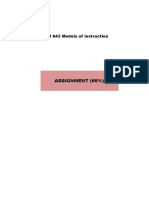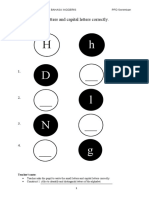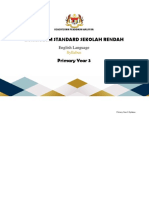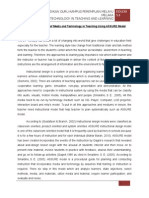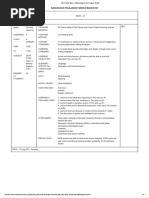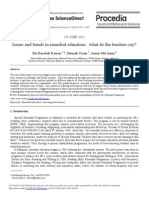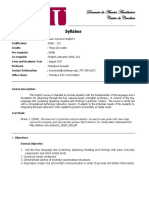Assignment (60%) : EMI 643 Models of Instruction
Assignment (60%) : EMI 643 Models of Instruction
Uploaded by
yuki_naCopyright:
Available Formats
Assignment (60%) : EMI 643 Models of Instruction
Assignment (60%) : EMI 643 Models of Instruction
Uploaded by
yuki_naOriginal Title
Copyright
Available Formats
Share this document
Did you find this document useful?
Is this content inappropriate?
Copyright:
Available Formats
Assignment (60%) : EMI 643 Models of Instruction
Assignment (60%) : EMI 643 Models of Instruction
Uploaded by
yuki_naCopyright:
Available Formats
EMI 643 Models of Instruction
ASSIGNMENT (60%)
This Guide explains the basis on which you will be assessed in this course during the semester. It
contains details of the facilitator-marked assignment.
One element in the assessment strategy of the course is that all students should have the same
information as facilitators about the Assignment. This guide also contains the marking criteria
that facilitators will use in assessing your work.
Please read through the whole guide at the beginning of the course.
Plagiarism
i) What is Plagiarism?
Any written assignment (essays, project, take-home exams, etc) submitted by a student
must not be deceptive regarding the abilities, knowledge, or amount of work contributed
by the student. There are many ways that this rule can be violated. Among them are:
o Paraphrases: The student paraphrases a closely reasoned argument of an author
without acknowledging that he or she has done so. (Clearly, all our knowledge is
derived from somewhere, but detailed arguments from clearly identifiable sources
must be acknowledged.)
o Outright plagiarism: Large sections of the paper are simply copied from other
sources, and are not acknowledged as quotations.
o Other sources: often include essays written by other students or sold by
unscrupulous organizations. Quoting from such papers is perfectly legitimate if
quotation marks are used and the source is cited.
o Works by others: Taking credit deliberately or not deliberately for works produced
by another without giving proper acknowledgement. Works includes photographs,
charts, graphs, drawings, statistics, video-clips, audio-clips, verbal exchanges such
as interviews or lectures, performances on television and texts printed on the web.
o The student submits the same essay to two or more courses.
ii) How can I avoid Plagiarism?
o Insert quotation marks around copy and paste clause, phrase, sentence, paragraph
and cite the original source
o Paraphrase clause, phrase, sentence or paragraph in your own words and cite your
source
o Adhere to the APA (American Psychological Association) stylistic format,
whichever applicable, when citing a source and when writing out the bibliography
or reference page
o Attempt to write independently without being overly dependent of information
from anothers original works
o Educate yourself on what may be considered as common knowledge (no copyright
necessary), public domain (copyright has expired or not protected under copyright
law), or copyright (legally protected).
Introduction
Academic Writing
b) Documenting Sources
Whenever you quote, paraphrase, summarize, or otherwise refer to the work of another, you are
required to cite its source parenthetical documentation. Offered here are some of the most
commonly cited forms of material.
Direct
Simply having a thinking skill is no assurance that children will use it. In
order for such skills to become part of day-to-day behaviour, they must be
cultivated in an environment that value and sustains them. Just as
childrens musical skills will likely lay fallow in an environment that
doesnt encourage music, learners thinking skills tend to languish in a
culture that doesnt encourage thinking (Tishman, Perkins and Jay, 1995,
p.5)
Indirect
According to Wurman (1988), the new disease of the 21
st
century will be
information anxiety, which has been defined as the ever-widening gap
between what one understands and what one thinks one should understand.
c) Referencing
All sources that you cite in your paper should be listed in the Reference section
at the end of your paper. Heres how you should do your Reference.
From a Journal
DuFour, R. (2002). The learning-centred principal: Educational Leadership,
59(8). 12-15.
From an Online Journal
Evnine, S. J. (2001). The universality of logic: On the connection
between rationality and logical ability [Electronic version].
Mind, 110, 335-367.
From a Webpage
National Park Service. (2003, February 11). Abraham Lincoln
Birthplace National Historic Site. Retrieved February 13, 2003,
from http://www.nps.gov/abli/
From a Book
Naisbitt, J. and Aburdence, M. (1989). Megatrends 2000. London:
Pan Books.
From a Chapter in a Book
Nickerson, R. (1987). Why teach thinking? In J. B. Baron & R.J. Sternberg (Eds),
Teaching thinking skills: Theory and practice. New York: W.H. Freeman and
Company. 27-37.
From a Printed Newspaper
Holden, S. (1998, May 16). Frank Sinatra dies at 82:
Matchless stylist of pop. The New York Times, pp. A1,
A22-A23.
This Assignment consists of Part A, B, C & D.
PART A (15%)
Write an essay titled:
My Philosophy of Teaching
Your essay (4 5 pages) will be judged based upon the following criteria:
An Introduction which lays down in clear simple terms your philosophy of teaching. The
Introduction should also present an outline of the points contained in the rest of the
essay.
A Body which contains at least three or four main points supporting your philosophy of
teaching. Each of these points should be illustrated with sound explanations and
excellent examples demonstrating your philosophy of teaching..
A Conclusion which reiterates your position and recounts the main points you have made
to convince the reader of your position and philosophy.
[Do not make any references or copy from the learning materials. They should reflect YOUR
OWN THOUGHTS ONLY] Not the thoughts of others!
PART B (15%) 5 pages
Watch the video clips about the flipped classroom and write a short essay titled The
Flipped Classroom. [You DO NOT need to make any references]
Guidelines:
What is the flipped classroom?
Conditions essential for the flipped classroom
To what extent can you implement the flipped classroom in the Malaysian setting?
PART C (10%) 3-5 pages
Read the article Commonly Asked Questions about Teaching Collaborative Activities by
D. Enerson, R. Johnson, S. Milner and K. Plank.
Answer the following questions using your own words:
What assignments / activities are appropriate for collaborative teaching?
How do you deal with conflict and help students learn in collaborative teaching?
How do you grade collaborative work?
Details about the Assignment [60%]
PART D (20%) 10-11 pages
hoose one model of instruction from this course and write a rationale for your choice. Be
sure to choose only ONE of the instructional methods, e.g.
Collaborative learning methods
Project and practical
Creative problem solving or synectics
Problem-based learning
Role-playing simulations
Inquiry method
Inductive method
and any other method
Write a Lesson Plan based on the method you have chosen. The plan is for one lesson,
which may last 45 to 60 minutes. You may use the following template:
a) Topic
b) Learning Outcomes
c) Background of the students
d) Duration
e) Prior Knowledge of students
f) Prosedure
a. Step 1 Set induction
b. Step 2
c. so forth
[Include the learning activities students will engage in, the types of questions you will ask,
how the teaching-materials will be used and so forth]
g) Teaching-learning materials to support the lesson [include the worksheet that you will
use and submit them as A4 size paper]
h) Teaching aids that will be used in your lesso [Take photographs of the aids and submit
them with your assignment.
i) Evaluation the instruments that will be used to evaluate performance
j) Closure
INSTRUCTIONS TO STUDENTS
a) Format for the assignment:
a. 12 New Times Roman font
b. 1 spacing
b) Submit online to MyPLS
c) Use the Front Cover name and ID.
END OF QUESTION PAPER
Cover Page
ASSIGNMENT (60%)
MAY 2014 SEMESTER
SUBJECT CODE
: EMI 643
SUBJECT TITLE
: MODELS OF INSTRUCTION
LEVEL : MASTER OF EDUCATION
STUDENTS NAME
:
MATRIC NO.
:
PROGRAMME
:
ACADEMIC FACILITATOR
:
LEARNING CENTRE
:
You might also like
- Maths in Focus Ext 1 SOLUTIONSDocument124 pagesMaths in Focus Ext 1 SOLUTIONSVanessaChen50% (4)
- SC DLP Y5 TS25 (Unit 7)Document7 pagesSC DLP Y5 TS25 (Unit 7)farisNo ratings yet
- Lesson Plan A Space TripDocument4 pagesLesson Plan A Space TripȘtefania Vasile100% (1)
- English Lesson Plan TemplateDocument3 pagesEnglish Lesson Plan TemplateWAFA BINTI MOHD AZIZAN MoeNo ratings yet
- ASSiGNMENT Eql671 Qualitative Research Methods Sept 2017Document6 pagesASSiGNMENT Eql671 Qualitative Research Methods Sept 2017Christina Peter0% (1)
- Instrumen Saringan Membaca Tahun 1Document13 pagesInstrumen Saringan Membaca Tahun 1Hirdawati Abdul HamidNo ratings yet
- QWERTYUIOP Lesson PlanDocument9 pagesQWERTYUIOP Lesson PlanSezgin KhooNo ratings yet
- ESL Amazing Race Lesson PlanDocument6 pagesESL Amazing Race Lesson PlanAnna Lyn MolonNo ratings yet
- Unit 1 Extra Test Without AnswersDocument4 pagesUnit 1 Extra Test Without AnswersNuria GL100% (3)
- University of Minnesota Unofficial Transcript Kelsey KovalaDocument4 pagesUniversity of Minnesota Unofficial Transcript Kelsey Kovalaapi-249843051No ratings yet
- EMI643 MODELS of InstructionDocument7 pagesEMI643 MODELS of Instructionyasini0% (1)
- Assign Curric Design Jan 2015Document8 pagesAssign Curric Design Jan 2015Peter TingNo ratings yet
- Assignment January 2015 SEMESTERDocument7 pagesAssignment January 2015 SEMESTERAbraham ZakariaNo ratings yet
- Fundamentals of Instructional Technology 0913Document4 pagesFundamentals of Instructional Technology 0913Rachel Ann BerenaiNo ratings yet
- The Place of Grammar in The Malaysian PrimaryDocument10 pagesThe Place of Grammar in The Malaysian Primarynurulshafieza100% (1)
- Unit 5 Blended Learning Lesson PlanDocument4 pagesUnit 5 Blended Learning Lesson Planapi-457866839No ratings yet
- Peka ScienceDocument31 pagesPeka Sciencescribd_lostandfoundNo ratings yet
- Saringan Diagnostik THN 2Document12 pagesSaringan Diagnostik THN 2Huda RuslanNo ratings yet
- English Paper 2 Year 2Document6 pagesEnglish Paper 2 Year 2NurulAinMatAronNo ratings yet
- Teks Perhimpunan Rasmi Bahasa MelayuDocument2 pagesTeks Perhimpunan Rasmi Bahasa MelayuazuranizamNo ratings yet
- Search in Complex EnvironmentsDocument28 pagesSearch in Complex EnvironmentsabinesanthoshNo ratings yet
- RPH - 1 (Measure and Record Masses of Objects)Document4 pagesRPH - 1 (Measure and Record Masses of Objects)Bong ChunNo ratings yet
- LINUS2.0 (Literasi Bahasa Inggeris) : Kementerian Pendidikan Malaysia Nkra - PendidikanDocument13 pagesLINUS2.0 (Literasi Bahasa Inggeris) : Kementerian Pendidikan Malaysia Nkra - PendidikaneinaNo ratings yet
- RPH Science Year 1Document4 pagesRPH Science Year 1waltersunggin2449No ratings yet
- Teacher'S /students' Activities Rationale / AvaDocument6 pagesTeacher'S /students' Activities Rationale / AvaAfiqah AbdulNo ratings yet
- Poison Tree - Moral ValuesDocument2 pagesPoison Tree - Moral ValuesEma AuzirNo ratings yet
- RPH30 18 SN T1 DLPDocument3 pagesRPH30 18 SN T1 DLPAqilah Abdul AzizNo ratings yet
- Storytelling Rules Primary SchoolDocument10 pagesStorytelling Rules Primary SchoolpardiemasNo ratings yet
- Kurikulum Standard Sekolah Rendah: English LanguageDocument22 pagesKurikulum Standard Sekolah Rendah: English LanguageCatherine KiuNo ratings yet
- Hmef5073 V2Document10 pagesHmef5073 V2Octavius GuNo ratings yet
- (10 Marks) (Time Suggested: 15 Minutes)Document8 pages(10 Marks) (Time Suggested: 15 Minutes)Asie MitNo ratings yet
- Lesson Plan Using An ASSURE ModelDocument7 pagesLesson Plan Using An ASSURE ModelAwan BaharimNo ratings yet
- Completed Task 2 Tslb1094Document5 pagesCompleted Task 2 Tslb1094Mimi AdrianaNo ratings yet
- 02c Pro-ELT Course InformationDocument2 pages02c Pro-ELT Course InformationAnonymous Val05Blj0% (1)
- Instrumen Saringan Menulis LBI Tahun 3 PDFDocument13 pagesInstrumen Saringan Menulis LBI Tahun 3 PDFSyamsul Qamar RosliNo ratings yet
- DSKP KSSR Tahun 4 Bahasa Inggeris SJKC-August-16-2021Document6 pagesDSKP KSSR Tahun 4 Bahasa Inggeris SJKC-August-16-2021mr. gohNo ratings yet
- EEA622.Educational - Assessment.jan.2015 - AnswerDocument31 pagesEEA622.Educational - Assessment.jan.2015 - AnswerKesavanVekraman100% (1)
- Format RPH English Year 2Document2 pagesFormat RPH English Year 2Mashitah Abdul Halim100% (1)
- Peralihan English 2016Document9 pagesPeralihan English 2016adkissNo ratings yet
- Lesson Plan Year 5 Primary UNIT 1 POEM Watching A Bumble BeeDocument2 pagesLesson Plan Year 5 Primary UNIT 1 POEM Watching A Bumble BeeSyafiq YusofNo ratings yet
- Free Time Unit 5Document26 pagesFree Time Unit 5Jammunaa RajendranNo ratings yet
- English 1 Yr 4Document8 pagesEnglish 1 Yr 4Leah HoffmanNo ratings yet
- PBD TRANSIT FORM - ENG YEAR 2 (Checklist)Document3 pagesPBD TRANSIT FORM - ENG YEAR 2 (Checklist)Chia DannyNo ratings yet
- QWERTYUIOP (Characters & Characteristics)Document2 pagesQWERTYUIOP (Characters & Characteristics)Zaty RusliNo ratings yet
- Scheme of Marking For 014 UPSR 2016 FormatDocument3 pagesScheme of Marking For 014 UPSR 2016 Formatawesome_teacher88% (8)
- Penataran Bahasa Inggeris UPPSVMDocument44 pagesPenataran Bahasa Inggeris UPPSVMMuhd Syafiq AshrafNo ratings yet
- Lesson Plan Year 2 CefrDocument4 pagesLesson Plan Year 2 Cefrpinkywawa88No ratings yet
- Proforma - gc6213 Teori Sem 1 2016 17Document6 pagesProforma - gc6213 Teori Sem 1 2016 17alfa xoxNo ratings yet
- Course Outline Lm2026k BM Kerjaya (Sains & Teknologi)Document9 pagesCourse Outline Lm2026k BM Kerjaya (Sains & Teknologi)Farhana AnuarNo ratings yet
- There Are Three Sections in This Paper: Section A, Section B and Section C. Answer All QuestionsDocument6 pagesThere Are Three Sections in This Paper: Section A, Section B and Section C. Answer All QuestionsNur Aleeza June ZakeyNo ratings yet
- Issues and Trends in Remedial Education: What Do The Teachers Say?Document8 pagesIssues and Trends in Remedial Education: What Do The Teachers Say?Bavani SagathevanNo ratings yet
- Civic Lesson Appreciate LeadersDocument12 pagesCivic Lesson Appreciate LeadersMaria Ahmad MalikeNo ratings yet
- Instrumen Saringan Membaca Tahun 3Document13 pagesInstrumen Saringan Membaca Tahun 3Noor IrinaNo ratings yet
- Examples of Teacher's Comments To Be Included in The PBD TemplateDocument7 pagesExamples of Teacher's Comments To Be Included in The PBD Templatewan isNo ratings yet
- Lesson Plan Short Stories Year 6Document9 pagesLesson Plan Short Stories Year 6Anwar RadhiNo ratings yet
- Listening& Speaking Year 5 KSSR ENGLISHDocument23 pagesListening& Speaking Year 5 KSSR ENGLISHimanzurynn161No ratings yet
- GCE L1 Exam Practice - AnswerDocument18 pagesGCE L1 Exam Practice - AnswerNOR AIKA IRFATINI BINTI ABU HASAN ASHAARI MoeNo ratings yet
- RPH YEAR 5 SJKDocument5 pagesRPH YEAR 5 SJKPriyaDhaarshini100% (2)
- Mutual Respect - Civic LP LowerDocument1 pageMutual Respect - Civic LP LowerKhiarani SaidinNo ratings yet
- Drake Reid 2018 Integratedcurriculumasaneffectivewaytoteach C21 Skills 1Document21 pagesDrake Reid 2018 Integratedcurriculumasaneffectivewaytoteach C21 Skills 1Melor FarhanaNo ratings yet
- Micro Teaching RPHDocument4 pagesMicro Teaching RPHNur FarhanaNo ratings yet
- Asgn ECS312 Sept 2017Document6 pagesAsgn ECS312 Sept 2017Husna ZakariaNo ratings yet
- Assignment: ECE 313 Science For Young LearnersDocument7 pagesAssignment: ECE 313 Science For Young LearnersedelzNo ratings yet
- Campus JournalismDocument10 pagesCampus JournalismMaricris Guarin MalamugNo ratings yet
- What Is A Good Language LearnerDocument24 pagesWhat Is A Good Language LearnerJia YiNo ratings yet
- Syllabus Cu Engl 101Document6 pagesSyllabus Cu Engl 101api-417692500No ratings yet
- 【伦理学】道德发展与现实 PDFDocument376 pages【伦理学】道德发展与现实 PDFbuhaptseren100% (1)
- Tu Elt 2017 ParticipantsDocument10 pagesTu Elt 2017 Participantsapi-285624898No ratings yet
- Appendix: Pre/Post Test Rubric: Each Question Is Worth 5 Points Each Out of 100, Converted Into 5 Pts. of Unit GradeDocument10 pagesAppendix: Pre/Post Test Rubric: Each Question Is Worth 5 Points Each Out of 100, Converted Into 5 Pts. of Unit Gradeapi-311747943No ratings yet
- Syllabus For MAMDocument114 pagesSyllabus For MAMRahul KapaleNo ratings yet
- HITEC University Taxila: Application For AdmissionDocument4 pagesHITEC University Taxila: Application For Admissionشاہد یونسNo ratings yet
- Study Abroad Partner Proposal Form 2018 FinalDocument7 pagesStudy Abroad Partner Proposal Form 2018 Finaldewi tanziIlatul arovaNo ratings yet
- 2015-2016 Syllabus FurgioneDocument1 page2015-2016 Syllabus Furgioneapi-203272417No ratings yet
- English PKSR 1 Year 4 (UPDATED)Document9 pagesEnglish PKSR 1 Year 4 (UPDATED)Aesha Farhana عاءشه فرحاناNo ratings yet
- Fazriel Fardiansyah Bin Abdul Kadir142743Document1 pageFazriel Fardiansyah Bin Abdul Kadir142743bsdhshfbsNo ratings yet
- Account-Age: Reg: Letter of Intent (LOI) /appointment Letter For Integrated Work Placement / InternshipDocument10 pagesAccount-Age: Reg: Letter of Intent (LOI) /appointment Letter For Integrated Work Placement / InternshipGiheNoidaNo ratings yet
- Seth Wright CV CcheDocument3 pagesSeth Wright CV Ccheapi-324211060No ratings yet
- Research Yancy Medt 7490Document11 pagesResearch Yancy Medt 7490api-307720108No ratings yet
- NÄR Newsletter Summer 2017Document4 pagesNÄR Newsletter Summer 2017Hulda Líf HarðardóttirNo ratings yet
- Exemplar Science Lesson Plan For Senior High School General Biology 1Document4 pagesExemplar Science Lesson Plan For Senior High School General Biology 1LG NiegasNo ratings yet
- Current CalendarDocument393 pagesCurrent CalendarAmar BenAmarNo ratings yet
- Conversations With Critical Thinkers IntroDocument3 pagesConversations With Critical Thinkers IntroLee ChonNo ratings yet
- Cooperative Learning Lesson Plan Edu 220Document4 pagesCooperative Learning Lesson Plan Edu 220api-297612302100% (1)
- Kra 2Document20 pagesKra 2Marisa N. Torre100% (1)
- 11 TTH Themes and MotifsDocument5 pages11 TTH Themes and Motifsapi-276599807No ratings yet
- ACFrOgA2-pMBqLsYYlPDyRbwKHhjL-D6DmZjiEQoP0qGKpXRwVEekBgNygEmaf6y6 6oQVXpns8b8xaQeVyBX8l V9O FRzbrvHMB0IgS6VgjdmprTZCUx4Cn2nnLa4Document2 pagesACFrOgA2-pMBqLsYYlPDyRbwKHhjL-D6DmZjiEQoP0qGKpXRwVEekBgNygEmaf6y6 6oQVXpns8b8xaQeVyBX8l V9O FRzbrvHMB0IgS6VgjdmprTZCUx4Cn2nnLa4Sericon BarrientosNo ratings yet
- Subjeact: Please Give The Information About Paradise College of Education 4 Milestone Pawti Road Jaurasi Samalkha Disst Panipat Under ACT RTI 2005Document4 pagesSubjeact: Please Give The Information About Paradise College of Education 4 Milestone Pawti Road Jaurasi Samalkha Disst Panipat Under ACT RTI 2005Deep LathNo ratings yet
- Reflection Micro TeachingDocument4 pagesReflection Micro Teachingel_YNNo ratings yet










